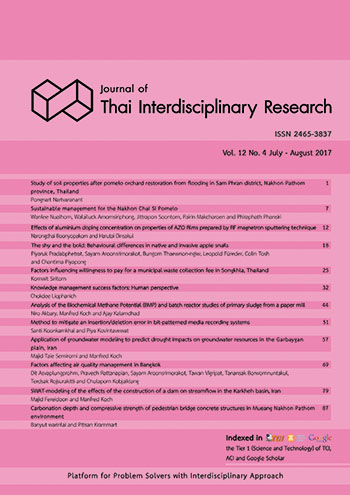SWAT-modeling of the effects of the construction of a dam on streamflow in the Karkheh basin, Iran
Main Article Content
Abstract
Hydrology and sustainable water development manner needs effective management of water resources, so it is necessary to understand the various watershed components with their governing processes. Therefore, in the present application of the semi distributed physically based Soil and Water Assessment Tool (SWAT) model in the Karkheh river basin (KRB) in the semiarid region of Iran, the filling of the gaps in the data series required to drive and calibrate the model, has been the first major task. Two methods, linear regression with the nearest station (LRN) and inverse distance weighting (IDW) are investigated for filling in gaps in the precipitation and temperature series at 10 weather stations. SWAT-CUP (SWAT-Calibration and Uncertainty Programs) is used for model calibration and sensitivity analysis, following the Sequential Uncertainty Fitting (SUFI-2) technique. Calibration and validation of the SWAT-model is performed on measured stream flows at 8 gauge stations for the 1985-1999- and 2000-2004 time periods, respectively. The calibrated SWAT-model performs fine for the prediction of the monthly streamflow at the outlets, as witnessed by the four following statistical measures: (i) P-factor, defining the percentage of observation data bracketed by 95 percentage prediction uncertainty (95PPU), (ii) R-factor: which is the relative width of the PPU, (iii) Nash Sutcliffe coefficient (NSE), and (iv) coefficient of determination of (R2). The P-factor values for the various gauge stations range from 0.62 to 0.94 and 0.60 to 0.88 for calibration and validation, respectively, which, according to literature, identify reasonable accuracy. NSE values are also acceptable, ranging from 0.52 to 0.82 and from 0.62 to 0.80 for calibration and validation, respectively. The same holds for the R2 -values which are also within an acceptable range. The Karkheh dam started its operation in August 2002, i.e. during the SWAT-model’s validation period, and its effect is clearly indicated by a significant reduction of the average annual streamflow in the two subsequent years 2003-2004, compared with that of the pre-operation period (1985-2001). Thus, the average annual flow volumes for the downstream gauge stations Pay-e-Pol and Hamidiyeh are, respectively, 2.19 × 103 m3 and 1.93 × 103 m3 in the 1985-2002- and 1.49 × 103 m3 and 9.66 × 102 m3 in the 2002-2004 time period, which corresponds to a reduction of 30% and 50%, respectively.

